#mughal coins for sale
Text
Coins of Mughal Empire
Buy Coins of the Mughal Empire online at Novelemporium, because it has the best collectibles, and the Mughal Empire, Which lasted from 1526 to 1858, issued a wide variety of coins during its reign. The Mughal emperors used various metals such as gold, silver, and copper to mint their coins
if you want more details you can directly contact us at [email protected] or visit our website at www.novelemporium.com
#Hindu Coins of Medieval India#Error coinsmedievalindia#british india coins#mughal coins in india#Mughal coins of India#mughal coins for sale#Ancient India Coins#Old medals of India#Republic India coins#Coins of British India#Coins of Mughal Empire#Ancient India Coins of Foreign Invaders#novelemporium
0 notes
Text
Buy Mughal Coins in India at Novelemporium
Actually, the reason is our website novelemporium is one of the best coin and notes dealing platforms in India. Where you can get 100% genuine products like Mughal coins, British India Coins, Republic Coins, and Other items If you want to need more info you can directly consult with us at +918867029800 or visit our website at www.novelemporium.com
#Hindu Coins of Medieval India#Error coins#mughal coins in india#mughal coins for sale#Ancient India Coins
0 notes
Text
Coin Book India | Coinage book | Unique coins sale
The Novelemporium is the best collection of coin book India ,there are several options available that cater to different aspects of Indian numismatics. But novelemporium published so many different coinage book in india like medieval coins,Guptas coins,mughal coins,british india coins books these coins book providing excellent information about all those coins in books.get the best coins collection by Noelemporium.
If you want more details you can contact us, we will assist you
Call: 8867029800
Email: [email protected]
Visit our website at www.novelemporium.com
#coinage book#coins book#coins stamps#coins and stamps for sale#limited edition coins in india#unique coins sale.
0 notes
Text
Antique coins for sale | Rare coins sale online

Welcome to Novel Emporium, your top online source for rare antique coins for sale. With a love of history and a commitment to upholding the splendor of the past, we provide a carefully curated assortment of superb old coins that will enthrall both seasoned collectors and beginners alike.
Every coin has a tale to tell, according to Novel Emporium. Every item in our collection has seen the expansion and contraction of empires, the passage of time, and the hands of countless people. You can connect with the past and preserve it for future generations by becoming the custodian of history by possessing an antique coin.
our website offers a variety of antique coins like the 1900 Silver One Dollar Coin, Silver 500 Tenge Coin, Civic Copper Falus Coin, Al Mamun Silver Dinar Coin, Burma Lead Coin, Mughal coins & many more.
Visit Novel Emporium to buy old collectibles
Our Head Office Bangalore, India
Call Us: 78294 10063 / 88670 29800
Email: [email protected]
Visit our website by clicking this: https://www.novelemporium.com/
1 note
·
View note
Text
0 notes
Text
A Guide to Buying and Selling Old Indian Coins
There are a lot of people who indian old coin buyer. When there are so many people interested in collecting and investing in old coins, it might be hard to know who to trust. In this article, we'll tell you about some of the best places for olindian old coin buyerd coin buyers in India. This way, you can make an informed decision about where to sell your coins. We'll also tell you how to find a buyer you can trust and what to watch out for when selling coins you don't want. So keep reading to learn more about who buys old coins in India!
Buying and selling old coins Indian buyers
Old coins are available in India in a variety of locations, including antique stores, coin dealers, and internet auction houses. Old coins might be worth more or less depending on their condition, rarity, and age, among other things.
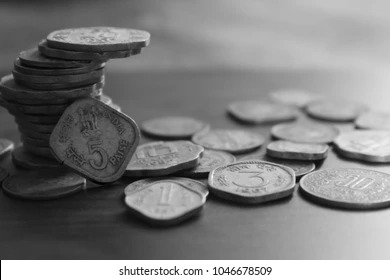
People who have old coin collections are typically willing to spend a significant amount of money on rare and historic coins. Typically, the most valuable coins are those that date back to before 1800. Typically made of gold or silver, these coins may also feature precious gems inlay.
If you want to sell your old coins for a higher price, there are a few things you can do to improve their marketability. First, verify the condition of the coins. The next step is to research the going rate for coins of a similar type at auction or online. Later, you must decide whether you will sell the coins in bulk or separately.
Why do antique coins have value?
There are a number of factors that contribute to why older coins are more desirable. Having stood the test of time alone gives these items sentimental value. A second reason they would be desirable to collectors is that they might be hard to come by. Third, they may be laden with valuable metals like gold or silver.
Fourth, there may be historical significance to collecting old coins. For instance, Mughal Indian coins from that era are highly sought for for their historical significance. Further, the magnificent designs and artwork on some older coins make them desirable collectibles in their own right. Beautifully designed coins, these.
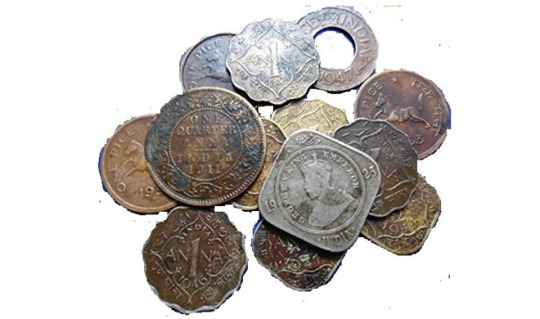
What are the advantages of purchasing antique coins?
One of the many benefits of investing in old coins is that they may be used to:
They have the potential to be very profitable.
They might be uncommon and meaningful presents for loved ones.
In certain cases, collecting them is a relaxing and interesting pastime.
You can increase the value of your home's decor by adding them.
Where in India can I buy ancient coins?
There are numerous locations in India where you may purchase antique coins. Searching online auction sites like eBay is one approach. A second alternative is to visit coin dealers in big metropolitan areas such as Mumbai or Delhi. You can also inquire with local antique dealers and jewellers, who may have old coins for sale.
sell old indian coins are one of the main ancient coins that are available in the market. These old coins have been kept for a long time and they cannot be seen in any other areas too. If you want to buy old coins at a cheap price, then you can visit or consult with our trusted coin dealers in India. These old coins are found in every field and they become more valuable over time.
How to care for old coins?
Old coins are one of the most fascinating collectables. But like most things in life, caring for your old coins requires a little effort and understanding. The first step is to let them sit out in the open so that you can inspect them for any noticeable flaws, cracks or other damage. Coins with missing rims may not be worth saving. Make sure the metal exteriors are in good condition before you begin any restoration work. Your next step is to get ready on how to care for old coins.
Copper coins and bars will tarnish over time; this is a natural phenomenon. Tarnish is the term for this discoloration. Any silver investor may wonder whether this is a positive or bad indication for their silver coins and bars at some point. This blog post will explain what causes silver to tarnish and what you can do to keep it looking its best.
Learn how to properly handle, clean, and store bars and coins by reading this article. Once you've decided to invest in precious metal bullion, you may use this guide to learn more about how to store silver coins, gold coins, and bullion safely and securely.
Although removal of all labels and rippled surfaces may not guarantee the safety of your antique coin collections, also keep in mind that if you store them with other items they may rub together and cause damage to each other. In addition to keeping them safely stored away from heat or chemicals one should also always remove old coins from their protective cases so that some small scratches may be hidden by the case or even allow for a unique detail on the coin to show through.
0 notes
Text
Buy Coins of India | Novel Emporium
Coins and notes play an integral part in our daily lives. Novel Emporium is an online platform with an extensively researched collection of coins, paintings, notes, and stamps. It is a haven for Notaphilists, Numismatists and Philatelists.

Browse through our latest collectibles quickly,
Buy Bank Notes of India
Buy Coins of India
British India Banknotes for Sale
Hindu Coins of Medieval India
Buy and Sell Indian Mughal Coins
Buy and Sell Coins of World Wide
Buy and Sell Ancient India Coins Online
Buy Postal Stationary of India
Buy & Sell Republic India Coin Online
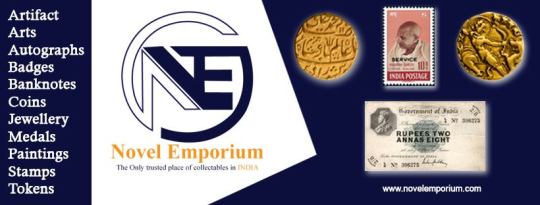
Buy and Sell Stamps of India Online | Stamps of India
Buy and Sell Stamps of Indian Princely State Online
British India Coins online
Buy Presidencies of India
Error coins of Republic India
#autographs of india#Buy Coins of India#Buy Coins of British India#Bank Notes of Republic India#Ancient India Coins#Error Stamps#Buy Miniature Sheet of India#Buy Postal Stationary of India#stamps of India#republic india bank notes#notes of india#coins#notes#stamps
2 notes
·
View notes
Text
A Most Fortuitous Discovery
Scholars have long speculated that a version of the playing cards we know today may have originated in China and travelled Westwards with the Mongol invasions. Along the way it is surmised that such games were adapted to suit the cultures into which they were introduced. It is known that such card games reached Iran, Mamluk Egypt and Syria at the start of the 14th Century. The Venetians, in turn, learned of cards via the saracens and took the games to Europe. Such is the basic history of the transmission of the game to the Western World. During this journey the game of cards took a left turn into India.
Rudolf von Leyden (1908-1983) suggested that the ganjifa cards may have been brought to India by the first Mughals from their ancestral homeland in Inner Asia. When English Ambassador Edward Terry, author of "A Voyage to East-India" visited in the first quarter of the seventeenth century, he saw ganjifa cards often. Modern ganjifa is usually round but rectangular cards were more common during the 18th-century and from records Persian cards were always rectangular. The circular shape of ganjifa was perhaps therefore an Indian innovation.
In December 2018 I chanced upon a small, hand-painted box at a car boot sale in West London and was able to buy it for £4. Measuring 100mm long by 60mm high and 50mm deep I really had no idea what might be inside - I just liked the box. The colourful abstract design within the cross hatching resembles a poppy but might be related to motifs involved in the suits of the contents.
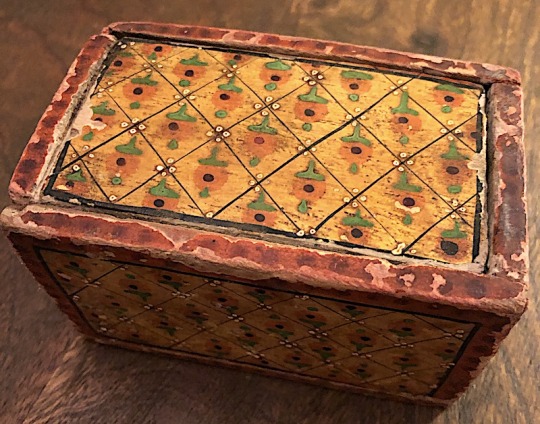
When I later opened the box I found what looked like a long circular tube resembling a thick piece of dowelling covered in fine green powder - mould in fact. On closer inspection I could see that congealed column comprised of a great number of discs that were stuck together. I spent much of that morning gently separating them and cleaning them with soft brushes.

Eventually I was able to establish that what I had were 92 distinct hand-painted discs about 45mm in diameter, plainly painted verso and forming eight families of a dozen. Clearly some sort of game. I had never heard of ganjifa and have little to no knowledge of card games and their variants beyond that gleaned from occasional play. Half an hour of internet research on my phone established that what I had acquired was a near complete and striking example of a Mughal Ganjifa pack in reasonable condition. I was captivated and intrigued.

The cards looked very old and I itched to discover more. Exactly how old were they? Where in India had they been made? What could I find out about this displaced cultural artefact, this strange exotic game, which had found its way into my hand by such serendipitous means
At the same time I began musing on what an incredible survivor any pack of used cards has to be to endure. Think about it: constantly handled, bent, torn, folded, tossed about, rubbed against one another, doubtless used in proximity to food and drink.... Totally ephemeral.
My first strategy was to see if I could find anything similar via Google image searches and hope that more might be known about decks with similar appearances. Might it even be possible to find identical decks by the same hand?
Eventually I found what I was looking for in two separate museums: the first one was displayed on a blog connected to the Ashmolean Museum in Oxford:

Strikingly similar exhibits within the collections identified as Mughal Ganjifa from Rajasthan dating to the 1790s. The second example was in the Fournier de Naipes Museum in Spain where even the box was the same colour and the card themselves, brighter and in better condition could easily have come from the same workshop!


I am not a Spanish speaker so I opted to contact an authority cited on the blog associated with the Ashmolean via email. I won’t name them here as I did not seek any agreement to publish their opinion, but based on the images I provided, it was confirmed that the “set is probably 19th century, and from Rajasthan.” That’s good enough for me. I note also that several auction houses dealing with Eastern art have sold very similar ganjifa sets for four figure sums. But what of my set, what am I to do with it? Perhaps I should continue by describing the game and displaying some more of the cards.
As has been noted above, the set I acquired is sadly four cards short (the phrase not playing with a full deck springs to mind!) It is exceedingly rare to find a full deck for reasons already stated and many individual or small groups of cards appear for sale all the time for surprisingly large sums. Each deck would have originally comprised 96 cards with 8 suits of 12 cards each. Each suit was based on an aspect of life within the Mughal court and there were four ‘strong suits’ and four ‘weak’ suits. The ‘strong’ suits (Bishbar) were Taj (Crowns or flowers), Safed (Silver Coins), Shamsher (Swords) and Ghulam (Servants). The ‘weak’ (Kambar) suits were Chang (Harps), Surkh (Gold Coins), Barat (Bill of Exchange) and Qimash (Packaged Merchandise). These Mughal suits are variously described elsewhere as slightly different things and within other forms of ganjifa the iconography can be completely different. Within each suit we have ‘pip’ cards from 1 to 10 and two ‘court’ cards: a Wazir (or Minister) and finally the Mir (or Shah). The Wazir is depicted as mounted on a horse depending upon the suit, in the Ghulam suit he rides an elephant, in the Surkh a tiger and in the Chang a camel. The Mir is depicted seated on a canopied throne flanked by servants or bodyguards. The obverse of all the cards is the same: a simple red field inscribed with a gold circle.
Here is the Mir of Taj indicated by the red and green ‘flower’ at the ten o’clock position:
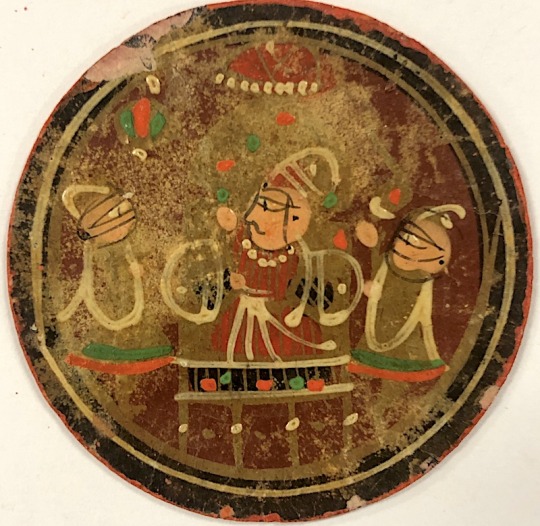
Next we have the Wazir of Taj riding a horse, again with the suit symbol at the ten o’clock position:

Continuing with the court cards we have the Mir of Safed with the chinha for the suit at the ten o’clock position. Note that the background colours are different to aid player identification:
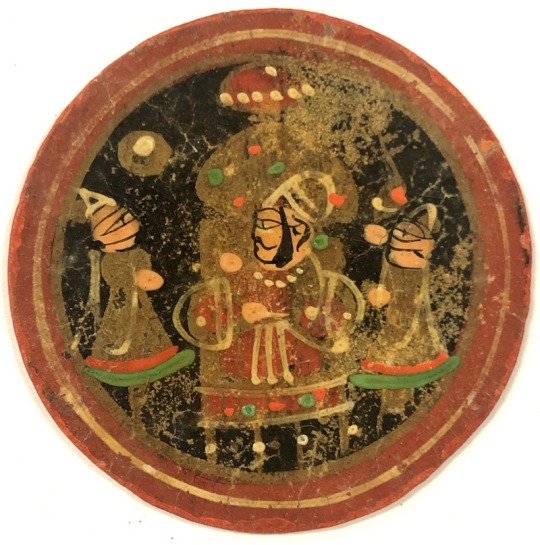
Next we see the Wazir of Safed riding a blue horse with red livery:
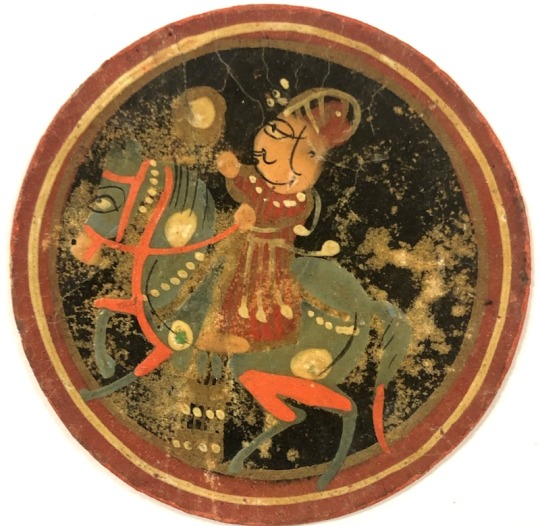
13 notes
·
View notes
Text
Opium, Addiction Treatment and the War For and Against the West
The last thing you want is a parrot invading your poppy fields and eating your poppy! That is, if you are an opium farmer from India…
Opium is the stuff of legends. Not only legends, but bloody wars (Opium Wars in China), illicit drug proliferation (by Taliban to ISIS), deceptively innocent hallucinations (as a heroin addict would admit), non-fiction books which are way high interesting than fictional works and (despite this) award winning novels (‘The Sea of Poppies’ by Indian author Amitav Ghosh)!
In fact, the loss of grip on opium benefits in India — its production and sale — marked the decline of the great Mughals. (It was apparently hijacked by a nondescript ring of Patna merchants). In 1757, a century before the first war of Indian independence, East India Company assumed the control of opium trade in India monopolizing the same, in a way. And by 1873, Lord Warren Hastings brought the entire opium trade under the crown’s total control.
Since independence, the India government dons the mantle of opium cultivation regulation in India.

This means opium has always been a lucrative commodity so much so that only governments and these days, terrorists, wield control of the same. In other words, the agencies that monopolise violence have a monopoly on opium! Opium in essence is power!
Coming back to the story of parakeets: in a district in India’s Madhya Pradesh state, the India government has licensed a few hectares of opium cultivation. This produce, along with output from other licensed areas in Rajasthan, is utilised in a variety of drugs, narcotic and non-narcotic.
License to Invade
Out here, in the district of Neemuch, parrots on a high, snoop in like ninjas without making as much as a sound.
“One poppy flower gives around 20–25 grams of opium. But a large group of parrots feed on these plants around 30–40 times a day and some even fly away with poppy pods. This affects the produce,” a beleaguered farmer harried by the incessant invasions of parrots complained.
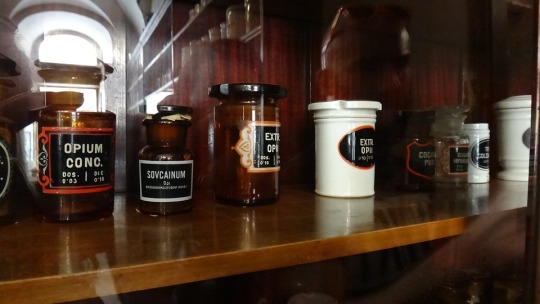
A potent commodity with the potential for ultimate use, abuse and misuse, the opium poppy can be cultivated only in such tracts as are notified by the India government.
At present these tracts are confined to three States of the nation: Madhya Pradesh, Rajasthan and Uttar Pradesh.
“Mandsaur district of Madhya Pradesh and Chittorgarh and Jhalawar Districts of Rajasthan constitute about 80% of the total area cultivated,” the government source notes.
The opium that is sourced by the government in a regulated mechanism with slabs determining the price for farmers is thus a priced commodity. It is then shipped to Government Opium and Alkaloid Factory in the State of Madhya Pradesh; the one-of-its-kind factory in India where it is processed to generate 13 products (those with triskaidekaphobia out there, take note!).
No wonder, expensive nets, shielding these Wakanda-like fields, are widely depended on by farmers.

The Unlicensed
If that is the rosy-poppy regulatory picture from India — depending on which side of the fence you are– the parrots’ or peasants’ — a sharp contrast is also there for you to behold. Come to Afghanistan. The world’s top most producer of illicit opium; in 2018, the region under poppy cultivation was 263, 000 hectares there! That is roughly ten times the size of Las Vegas; the sin city! Imagine, ten times the sin!
A hectare of opium yields 24.4 kilograms. A simple calculation will tell you that 6400 tons of opium was produced in 2018 in Afghanistan. That is a far cry from 9000 tons in 2017; blame it on drought. A whopping 604 million USD will be accumulated by this bunch of opium. That is roughly 2,46,26,28,800 MYR; a staggering, mind-blowing sum. A chunk of this will find its way to terrorists who not only tax the opium farms but also protect the same, for obvious reasons. And you are talking ending of the War on Terror. It is a war of attrition that is being waged!
And all these drugs derived from the opium will find its way to Europe, Asia, Africa and eventually USA.
The social fabric in many of these societies is being torn apart, courtesy of drugs: synthetic and others. As bullets are fired, as shells bombard, as fighter jets blitzkrieg, the karma of US and other nations ensure that it is paid back, not in the same coin; but a much more lethal and potent one.
The Western forces in Afghanistan pump in billions of taxpayer Dollars to fight terror. Taliban cultivates all the poppy in the world, colludes with the drug ecosystem and raises money from the same taxpayers of the said nations by selling drugs to them, to fight the Western ‘occupation’. How ironic!
The taxpayers in US and the allies are funding two wars at the same time: war for them and the war against them; and guess what, are getting slowly dissolved in a deluge of drugs in the process!
So far, so surreal!
The Treatment Solution
While one may think that the fight against Taliban is indeed the fight against opium, that bombing the fields may yield better results than bombing obscure caves, the reality is even more complex or complicated.
The Afghan opium production can be a direct result of the state of security — human security — and livelihood. When your kid cries out of hunger and all you have is havoc wreaked village with bullet holed shelters or shacks to take cover, you would never think of living, but only about surviving.
The Poppy plants do not demand much from its cultivator in terms of light and water. All it needs is a dent on the earth to deepen its root and grow. And when the dent exists in the minds of a war-torn nation, it could easily be dug on the grounds. Not by one, but by a multitude.

When you are protected by the Taliban, all because you have a piece of land growing poppy, you would love the poppies even more!
This is as much an escape and distorts the market structure. There is little incentive to grow other crops. People also tend to take refuge in poppy derivatives to forget the pain in everyday life.
“The 2015 Afghanistan National Drug Use Survey, the first survey to use 100% toxicological screening to assess drug use across Afghanistan, showed Afghanistan’s national drug use rate is 11%, one of the highest in the world. Rural drug use rates were shown to be nearly three times higher than in urban areas, with 13% of the Afghan rural population testing positive for drug use, versus 5% in urban areas. Approximately 9% of Afghan children overall in the survey tested positive for one or more drugs; in rural areas 11.3% of children tested positive.” Afghan National Drug Action Plan 2015–2019, states.
Invariably, this has only got a human solution.
By addressing the high level of drug use in rural areas, including the socio-economic factors and by intensifying and taking leadership for training and credentialing clinical staff of treatment programs; by expanding recovery support services and promoting the substance use treatment system in Afghanistan, the issue could be tackled.
If it can win in Afghanistan, it can win anywhere else in the world!
Source: Solace Asia.com
#drug#addiction#addiction treatment centers#addiction treatment#addiction treatment center#top 10 illegal drugs#opioids drugs#poppy plant#afeem#afeem benefits#opioid addiction
1 note
·
View note
Text
Autographs for Sale India | Autographs of India
Autographs for Sale in India. Choose from our collection of signatures of legends of India through Novel Emporium. You can Buy and sell Coins, Notes, Autographs, Stamps and many more collectibles at the best prices.
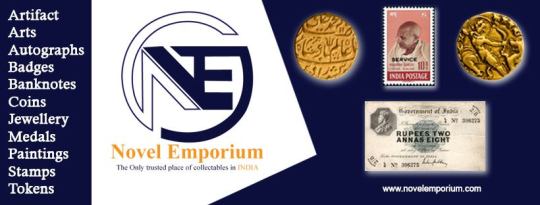
Other Collectibles at Novel Emporium
Ancient India Coins
Ancient India Coins of Foreign Rulers
Autographs of India
Bank Notes of British India Period
Bank Notes of Republic India
British India Coins
Coins of Worldwide
Hindu Coins of Medieval India
Independent Kingdoms of India Coins
Indian Sultanate Coins
Medallions
Miniature Sheet of India
Mughal Coins of India
Postal Stationary of India
Stamps of India
0 notes
Text
Aina Mahal, Parag Mahal, Kutch museum: Here’s why Bhuj is a craft lover’s paradise - travel
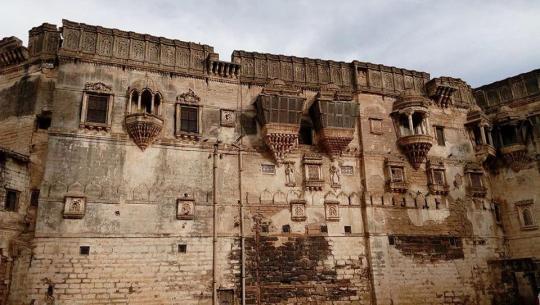
Bhuj, once the capital of the prosperous princely state of Kutch, was among the richest towns in the region, whose wealth was derived from its sea trade with the East Africa and the Persian Gulf. The bartering of African slaves with India’s textiles, was an important part of the Kutch maritime trade. Many of the families are descendants of these slaves who have settled down in Kutch and are still seen in the area. Bhuj also continues to be a major textile hub attracting millions of people from across the world.Over the years, despite some disastrous earthquakes, decades the city always manages to attract people from all over India and abroad. Bhuj is a real paradise for those who love to shop in the bazaars famous for the region’s beautiful handicrafts and jewellery. The most frequently visited places for tourists on a trip to Bhuj, are the magnificent Aina Mahal, the bell tower at Parag Mahal, the Kutch museum believed to be the oldest museum in the region and Hamirsar Lake. There is also the Sharadbaug Palace, which was the residence of Madan Singh the last ruler of Kutch, till he passed away in 1991.ALSO READ: 2020 will bring 9 long weekends, here’s the full list and how you can plan your holidaysAs in the case of many other heritage sites, there is an interesting legend about its name. It is said that Kutch was ruled by Naga chieftains in the past. Sagai the beautiful queen of Sheshapattana allied and married King Bheria Kumar, and persuaded him to rise up against Bhujang, the last Naga chieftain. Bheria was defeated and in keeping with tradition, Sagai committed sati after the battle. The hill where Bhujang had lived came to be known as Bhujia Dungar and the town at its foothill was named Bhuj.Bhujang was later worshipped by the people as a snake god who called him ‘Bhujanga’. A temple as built in his name that attracts pilgrims who continue to worship him, till today.History tells us that Bhuj the city, was established by Rao Hamirji in 1510 and was made the capital of the State of Kutch by Rao Khengarji in 1549. Its foundation stone as the state capital was formally laid in January 1548. After 1590, when Rao was forced to acknowledge Mughal supremacy, Bhuj was known as Suleiman Nagar’ among Muslims. The Bhujiya Fort was built by Devkaran Seth, around the 1730s while the city walls were built by Rao Godji 1 in 1723. These walls unfortunately were not as effective as they should have been. They were attacked on six occasions, but were able to push back the enemy only on two occasions. The last attack was on 26th March 1819 when the hill fort of Bhujia was captured and went into the hands of the British army.Bhuj, unfortunately, appears prone to earthquakes, the first one being on June 16, 1818 when the town only had a population of 20,000 people. The earthquake destroyed 7,000 houses killing more than 1100, people. About one-third of the buildings that escaped ruin, were heavily damaged, and the north face of the town wall was totally flattened out. The next earthquake, was much more disastrous and shook Kutch in 2001. At the time as capital, Bhuj was considered a fascinating walled city with beautiful palaces, bazaars and havelis.After the earthquake, it was so badly affected, that there were talks of bringing the remaining parts of damaged buildings down, to ensure safety. The Aina Mahal an 18th-century palace, was built by Rao Lakhpatiji in 1761. The chief architect and designer of Aina Mahal was Ram Singh Malam, assisted by local mistris. It was constructed with marble walls adorned with gold filigree and glass. The marble walls of the palace are covered with mirrors and gilded ornaments of Venetian glass. The palace was damaged in the earthquake in 2001, however, a portion of the palace which was not too badly damaged has been restored and houses the museum. This includes the royal bedroom with its walls covered with Venetian glass mirrors, a music room, a courtroom, antique furniture, arms, a palanquin and paintings.Prag Mahal named after Rao Pragmalji II, was commissioned by him and construction work began in 1865. It was designed by Colonel Henry Saint Wilkins in the Italian Gothic style, using Italian Marble and the best variety of sandstone from Rajasthan. Many Italian artisans were involved in its construction and their wages are said to have been paid in gold coins. The construction of the palace, which ultimately cost 3.1 million rupees, was completed in 1879, during the rule of Khengarji III (Pragmalji II’s son) in 1875. ALSO READ: Travel on the cards? Here are a few offbeat destinations for backpackers in and around IndiaThe locally skilled Kutchmmistris were once again involved in this project, helping Colonel Wilkins, to create the elegant Prag Mahal.The Prag Mahal Palace was severely damaged by the earthquake in 2001, but worse was yet to come. Thieves burgled the Palace in 2006, managing to carry away antiques worth million of rupees - and damaging all the items that they could not carry away! These included imported chandeliers and statues from the Durbar Hall and stuffed animal heads from the walls of the Main Hall. While it may not be possible to bring back to its original state, the Palace exterior is more or less restored. The halls in the palace and the tower have also been repaired and are open for public viewing. Visitors can now enter the main palace halls and climb up the stairs of the bell tower, which offers splendid views of the city.Bhuj is a famous destination within India for observing the historic craftsmanship of the Kutch region, including the textile crafts of bandhani (tie-dye), embroidery, and leatherwork. Artists of nearby villages bring their exquisite artwork for sale at the Bhuj Haat, which is situated near the Jubilee Ground.(This story has been published from a wire agency feed without modifications to the text. Only the headline has been changed.)Follow more stories on Facebook and Twitter
Read the full article
#acrylicpaint#artgallery#artsupplies#artist#at#deviantart#finearts#gallery#howgreatthouartchords#howgreatthouartlyrics#howtomakechannelart#metropolitanmuseumofart#modernart#paintonline#print#sculpture#watercolorpainting#whatisaliberalartscollege#whatisabstractart#whatisartdeco#whatiscontemporaryart#whatisfinearts#whatisliberalarts
0 notes
Text
Hindu Coins of Medieval India
Buy Hindu coins of medieval india online at Novelemporium, because it has the best collectibles and novel emporium In the middle ages, India saw the rise of numerous kings and kingdoms, each of which produced its own currency. Some of the most renowned medieval coins from this time period demonstrate the importance of that era's money to contemporary audiences. Mughal coins, british india coins, Ancient india coins, etc
if you want more details you can directly contact us at [email protected] or visit our website at www.novelemporium.com
#Hindu Coins of Medieval India#Error coinsmedievalindia#british india coins#mughal coins in india#Mughal coins of India#mughal coins for sale#Ancient India Coins#Old medals of India#Republic India coins#Coins of British India#Coins of Mughal Empire#Ancient India Coins of Foreign Invaders#novelemporium
0 notes
Text
Novelemporium online coin platform is one of the best coin platforms in India here you can purchase 100 authentic/ genuine old coins, ancient coins, antique coins and etc. Because the novelemporium is certified by Marudharaarts so that the reason here you can get all benefits at Novelemporium. For need more information you can directly consult with us otherwise, you can directly visit our website at www.NovelEmporium.com
#Indian Sultanate Coins#medieval coins of india#mughal coins in india#Mughal coins of India#mughal coins for sale
0 notes
Text
They tyranny of routine
Bombay. The city of lights. Maximum city. 20 million people stuffed across 600 kms. I see hundreds of them every day on my commute to work. They are all the same, and they are all different. A different face sits next to me in the metro every day. A different one walks ahead of me on the skywalk. A different one sits across from me during the 40-minute-long train journey. The journey is the same, but I travel with a different entourage every day.
Sometimes I take the 8.33 am train for a few days in a row and see the same faces in different clothes, in different moods, spending those 40 minutes in the ladies compartment doing different things each day. One girl settles into the seat and purposefully opens up a book, a Jeffrey Archer, but only for a few minutes before sliding her phone out from her bag and scrolling and scrolling and scrolling ... before long, the train has reached Lower Parel and it’s time to get off. Another girl usually picks the window seat, clutches her backpack close to her chest, and simply stares out the grilled window throughout the journey, her eyes distant, searching. I wonder what she is thinking. Some others habitually stare at others in the train, often munching on snacks they carry in their bags. An old lady sits quietly with a small book of what look like Sanskrit verses, her head following the sentences from left to right. Occasionally there is a girl or two studying from a coursebook, sometimes scribbling notes, maybe finishing homework.
Some girls look much younger to me, maybe they’re in their teens. I don’t like to look at them. They make me think about my life as a teenager, and how naive, and relatively uncool I was. Other days I am fascinated by them, their dressing sense, the way they carry themselves. Sometimes I make up stories in my head about what their life would be like. I try to guess their likes and dislikes, their career aspirations, what they may be like on social media. Others are older, and make me wonder whether like them, I’ll still be travelling in this ladies coach when I’m 30 or 35 or 40. Sometimes I feel like they’re mocking my dreams. “You’re going to spend your whole life travelling in this 8.33 am train.” Some wear mini skirts. Others wear headscarves. Some have tattoos on their neck, or shoulder, or ankle. Others have scars. Some carry branded handbags. Others carry jute baskets full of vegetables for sale. Some girl is on the phone discussing a project she needs to submit. Another girl, wearing a corporate suit, is dozing off, her mouth half open and head thrown back, resting on nothing, swinging in perpendicular motion with the train.
I get off at my station, as do hundreds of other men and women. We all make our way towards the stairs. There’s only one exit. Lots of white shirts. Some men stop at the shoe shine boy sitting next to the stairs. They look amusing to me, standing there like the Mughal kings would for a photograph - chin up, one leg resting on a small pedestal, the other on the floor, and a poor, dark-skinned boy sitting at their feet, rubbing polish on the shoes. This right here is a classic Indian stereotype ... straight out of a Slumdog Millionaire. I chuckle, and follow the robots marching towards the stairs - left, right, left, right, left, right. You can’t walk any faster, there’s no space. One step at a time. Get out of the station. Get into another queue - this one is for the share cab.
The sun is right overhead. One by one, people get into cabs in groups of four. What bunch of people do I have around me today? Two corporate blokes. A girl with pink earphones. A very old man with a big grey moustache wearing a dhoti. He sits next to me once we get into the cab. He takes out a 10-rupee note and hands it to me, and so do the others. I am sitting closest to the driver. I dig into my bag for my wallet. Crap. I don’t have any cash. Not even enough coins, just 4 rupees. The man in the dhoti is looking at me. He digs into his kurta pocket and takes out 6 rupees, hands the coins to me. I try to refuse, but have no option but to take the favour. I hand the money to the driver, and it’s already time to get off. I turn to the man in the dhoti and ask if he will be in the queue at the same time tomorrow. He says he is not from Mumbai. He will go back to his village this evening, but that I should not worry about the money. I don’t know what to say. How should I return the money? Should I ask for his number? How will that help? My stop is here. I hurriedly get off, and turn around to look at him but the cab is already moving.
I stand there for a minute, then start walking towards the gate of my office, thinking hard. That was not cool. He did not look like he could afford to loan me any money. Even if he did, I should have refused it on principle.
I wondered who he was, where from, and what his life was like. Would he go back to his village and tell anyone he loaned 6 rupees to a random stranger in Mumbai? I don’t want to forget his face. But I know that in a few days or weeks or months, my mind will erase my memory of his face.
He will turn into one of the many faceless people I see every day.
#am writing#writing#bombay#local train#mumbai local#india#desi#brown girl#brown people#indian#stories#short stories#fiction#fictional characters#fictiion writing#life stories#my life#everyday mumbai#kindness#strangers
0 notes
Text
SARC Auction 37 Nets $1.85 Million
The folks at Stephen Album Rare Coins bring a substantial base of combined knowledge to the process of cataloging their high quality, diverse consignments. I think also that their bidders tend to be very well versed in the specialized fields in which they collect or trade. It is for these two broad reasons that I really enjoy bringing our readers previews or reviews of the SARC live and online auctions.
SARC Auction 37 was held June 11-14, 2020, at their offices in Santa Rosa, Calif., with great results. Both the strength of the coin market and of the SARC business model was on display as high prices and a huge sell-through of 96.5 percent of lots sold made this a fun event for all involved. I asked Michael Barry, Chief Operating Officer (COO) at SARC for sale totals and he supplied this information, “The total price realized was 1.85 million USD (including buyer’s fees), a new record for our growing auction house. Pre-sale estimate for the auction was 1.20 million USD.”
The “Pavilion” dollar was issued to commemorate the succession of Hsu Shih-chang to the office of President in 1918, and in celebration of his 67th birthday. This example was engraved for Dr. Ralph Garfield Mills and realized $130,900 with buyers’ premium.
One of the most exciting moments in SARC Auction 37 came when a Chinese silver “Pavilion” dollar sold for an astounding price of $130,900. Joseph Lang, CEO and Director of East Asian & Later Indian Numismatics relayed that, “This is more than three times higher than previous sales records for a Pavilion dollar (based on auction records available on CoinArchives Pro). The reason for the record-breaking price is that this piece was engraved for Dr. Ralph Garfield Mills (1881-1944) of Lincoln, Ill.”
I was only vaguely familiar with Dr. Ralph Garfield Mills before reading this wonderful background on him from the SARC Auction 37 lot listing:
“Dr. Mills was Professor of Pathology and Director of Research at Severance Medical College (now Severance Hospital of the Yonsei University Health System), from 1911 until 1918 in Seoul, Korea. According to the Johns Hopkins University circular “Annual Report of the Johns Hopkins University 1913-14” published in Baltimore, Md., in 1915, Dr. R. G. Mills, “an instructor in Pathology and Surgery resigned to become Professor of Pathology and Surgery in the new Peking Union Medical College in Peking, China in 1918.” He was also listed as the Vice-President of the Korea Branch of the Royal Asiatic Society in Seoul in 1916. In 1923 Dr. R. G. Mills was again head of the department of pathology of the Peking Union Medical College and he wrote about the previous year in which “two of the contending war lords whose forces were clashing near Peking retired from the sanguinary scene of their conflict leaving several hundred wounded soldiers in an old temple. The Peking Union Medical College authorities commandeered all the suitable vehicles that could be found and brought the wounded men into the great city hospital.” Dr. Ralph G. Mills and his wife, Ethel, served as missionaries in Korea and China.
CFO and Director of World Coins, Paul Montz, was happy with their Auction 37 results. “We were curious to see how this auction would do, with all the changes the pandemic has forced on the industry. We were pleased to see that the market appears to be stronger than ever. This strength carried throughout the auction in all categories.”
To prove the point, here are some additional stand-out highlights directly from the sales catalog with results tacked on after the pre-sale estimates:
LOT 1066: INDIA: MUGHAL EMPIRE: Jahangir, 1605-1628, gold square heavy mohur, Lahore, AH1015 year 2, KM-184.1, BMC-293 (1015 year 1) & 294 (1016 year 3), special presentation type from the early part of Jahangir’s reign, obverse legend has full name & patronymic shah nur al-din jahangir ebn akbar padshah, and the regnal year “2”; reverse legend ruy-e zar-ra sakht nurani be-rang-e mehr o mah, ”he made the face of money to shine with hues of the sun and moon,” and the mint formula zarb lahore, NGC graded AU-55. Estimated at $14,000 – 16,000 (Realized $26,180).
A beautiful square heavy mohur of the Mughal Empire under Jahangir. Both round and square heavy mohurs were struck during the first six years of his reign, replaced by standard weight rupees and mohurs during year 6. This is one of the best examples you will find. It realized $26,180 with buyer’s fee.
LOT 1462: CHINA: CHIHLI: Kuang Hsu, 1875-1908, silver dollar, Peiyang Arsenal mint, Tientsin, year 24 (1898), Y-65.2, L&M-449, dragon eyes in relief, a superb quality example with bright white original mint luster, a superb example. PCGS graded MS-63. Estimated at $15,000 – 20,000 (Realized $26,180).
LOT 816: MEDIEVAL ISLAMIC: ASSASSINS AT ALAMUT: Muhammad III, 1221-1254, gold dinar (2.56g), MM, AH618, A-D1920, dated in the year of his accession, citing the Abbasid caliph al-Nasir li-din Allah, slightly uneven surfaces, unpublished and almost certainly unique and of great historic importance, VF-EF, RRRR. Estimated at $4,500 – 5,500 (Realized $16,660).
LOT 1757: WORLD: THAILAND: Rama IV, 1851-1868, gold stamped fuang, ND (ca. 1856), Cr-170, Krisnadaolarn & Mihailovs, p. 150, plate F07, upper left, stamped with four marks: chakra, mongkut, and phra tao (twice), grained right on the edge (derived from coins of the Indian Presidencies), EF, RRRR. Estimated at $2,000 – 3,000 (Realized $9,520).
LOT 102: ANCIENTS: SASANIAN KINGDOM: Shahpur (Sabuhr) I, 241-272, gold dinar (7.30g), Ctesiphon, G-21, diademed bust of Shapur right, wearing mural crown with korymbos // fire altar flanked by two attendants, each looking away from the fire and wearing mural crowns, two pellets right of the altar, lustrous and well struck example. ANACS graded MS-64. Estimated at $3,500 -4,000 (Realized $5,355).
SARC Auction 37 also offered selections from the H.F. Bowker Numismatic Library. Here too, prices were quite strong, particularly for some of the out of print works which have become increasingly difficult to locate. Here is one of the most outstanding highlights from the Bowker lots:
LOT 3689: NUMISMATIC LITERATURE: Schroeder, Albert, Annam Études Numismatiques, Paris, 1905, original printing, 651 pages, 111 fine phototype plates, in two volumes, one of text and one of plates, contemporary red cloth binding, original paper covers with the text volume hardbound, the standard French-language work on Vietnamese cash, silver, and gold and still the best work on gold and silver coinage, now extremely rare, RR, ex. H. F. Bowker Numismatic Library. Estimated at $300 – 500. (Realized $4,760).
Of course, I always like to dig a bit further and look for items which may have been overlooked by many, but were certainly seen by specialists. These are coins which may not have brought the stunningly high hammer prices, but which I had an eye on with high expectations. In most cases, in this sale these little trendsetters did not disappoint.
Early Panamanian coins in high grades always bring active buyers. This 2-1/2 centesimos of 1929 is the finest known example graded by either service at this time.
A Panama 2-1/2 centesimos of 1929, a one-year type as are many in the early coins of Panama, graded MS-66 by PCGS realized $2,200 on an estimate of $100-$150. The MS-65 value in the current Standard Catalog of World Coins is $165, but it is quite hard to locate these in grades any higher than that. An MS-66 is an oddity for the type and might be the finest known example, as NGC has not encountered any examples above MS-65 and this seems to be the first MS-66 graded by PCGS.
The Military bust of Yuan Shi Kai has been collected fervently in the dollar denomination for years. The fractionals, like this 10 cents, are now also in high demand and realizing staggering prices in the highest available grades.
The China Republic coins of Year 3 (1914) with Yuan Shi Kai in military uniform also did extremely well in SARC Auction 37, with a 10 cents and 20 cents each graded by PCGS as MS-64 realizing $2,400 apiece. In the past it was the dollar denomination which garnered the most collector interest, but those crown attitudes are changing. These prices were nearly 10 times each coin’s pre-sale estimate, so people are certainly paying attention now. Even the Yuan Shi Kai Year 3 (1914) 50 cents graded PCGS MS-62 realized a whopping $6,500. Those are shocking prices to me, and apparently to the SARC folks too. It’s definitely an area to watch.
The same is true of the Republic of China Dragon and Peacock coat of arms types Year 15 (1926) 10 and 20 cents in the sale. They were each graded MS-64 by PCGS and each realized a stunning $3,750. Collector or investor interest is really high right now for the minor types.
Deeply struck and nicely separated countermarks add to the eye appeal of this St. Eustatius countermarked stuiver. Locating one with both countermarks is difficult.
On the less traveled path, SARC Auction 37 offered a St. Eustatius double countermarked stuiver. The original SE countermarked 2 sous of St. Eustatius are offered for sale pretty often. You might see one or two for sale in any given year, without even looking too hard, but the second issue with SE and a second countermark of P are not often seen at all. The piece in SARC Auction 37 is a KM-4, one of only two ever available types with both the original SE countermark and the P countermark which was applied later. The 2 sous host coin is from the French colony of Cayenne, which today is the main city in French Guiana on the northeast coast of South America.
Background on St. Eustatius countermarked coinage in use during the British occupation of the island was provided through the SARC Auction 37 lot listing: “It was determined that only genuine Cayenne stuivers would be used as currency on St. Eustatius, and these were countermarked “SE” for St. Eustatius by Peter dit Flamand. In 1809, there were so many counterfeits in circulation that an additional “P” stamp was applied to genuine pieces.” There are several different versions of the SE stamps known, but I think there are only two P stamps confirmed. One has a double lined upright and rests in a plain circular indent. The other type is a raised solid P in a circle of dots, all in an incuse circle.
The SE and P stuiver in SARC Auction 37 was graded VF for countermarks and AG for the host. I would have placed it higher for both, based on typical appearance for these types. Either way, the pre-auction estimate range of $250-$350 was left far behind when the lot sold for $900, which is the exact value listed in the current SCWC for a VF example.
High grade Iraq mid-20th century types continued to surface at SARC in Auction 37. The one that caught my eye was a copper fils for Faisal I dated 1933/AH1352. This coin was graded MS-65 brown by PCGS. Again the final price was just short of 10 times its pre-sale estimate at $1,300. This type was a large mintage coin, but survival at this grade level must be very thin.
Finding high-grade coins of Lebanon from the French mandate era leading up to WWII can be difficult. But they do come up; as did a silver 25 piastres dated 1936 and struck at the Paris Mint. It’s one in a series of three denominations using this beautiful design of the traditional Lebanese arms and crossed cornucopias. Graded MS-63 by PCGS, the coin sold for well above its pre-sale estimate and even went above its catalog value by over 40 percent.
The Nepal highlight of SARC Auction 37 was a copper paisa struck under Tribhuvira Vir Vikram who ruled from 1911-1950. You’ll find that in the Standard Catalog of World Coins he is listed as Tribhuvana Bir Bikram, but I will leave pronunciation and spelling arguments to more educated language experts. The coin itself is cataloged as KM-686.2 and is noted as “believed to be a pattern.” If I recall correctly, this listing originated with the owner and current consigner of the coin Wolfgang Schuster. At the time it was added to the SCWC we had little idea of its value, except that it was quite rare. The final hammer price was $650, giving us a better notion of value today.
Both high-end and mid-range world coins were well represented in SARC Auction 37 and most everything sold and sold for premium value, as CFO and Director of World Coins, Paul Montz described. Consider it a good sign for the world coin market and a terrific indication of the growth of this firm. Look for more exciting sales in SARC’s future.
For more information see www.stevealbum.com.
The post SARC Auction 37 Nets $1.85 Million appeared first on Numismatic News.
0 notes
Text
A Brief History of Jewelry Through the Ages
Jewelry has been an integral aspect of human civilization for centuries, but it was the discovery and subsequent spread of precious metals and gemstones which really changed the game.
In today’s infographic from Menē, we visualize how the uses and symbolism of jewelry have evolved across time and space to become the industry we’re familiar with today.
Antique, Yet Ageless
There isn’t a single corner of the world that’s untouched by the influence of jewelry.
Ancient Egypt
Gold accompanied the affluent into the afterlife – the famous 1922 discovery of King Tutankhamun’s tomb was filled to the brim with gold jewelry.
Ancient Greece and Rome
Jewelry was used practically, and as a protection against evil. The gold olive wreath design was highly popular during this time.
Mesopotamia
Both men and women in the Sumer civilization wore intricate pieces of jewelry, incorporating bright gems like agate, jasper, or lapis lazuli.
Meso-America
The aristocracy in Aztec culture wore gold jewelry with gemstones to demonstrate their rank. The jewelry also doubled up as godly sacrifices.
Ancient India
The Mughal Empire introduced the combination of gemstones with gold and silver. Today, pure gold jewelry is often gifted to new brides for financial security.
Ancient China
Both rich and poor wore jade jewelry for its durable and protective properties. Pure gold jewelry is making a fashion comeback, doubling as a form of investment.
Modern Jewelry: At a Crossroads
Today, jewelry is at once the very same and vastly different from what it used to be.
The industry is worth upwards of $348 billion per year, and it’s not hard to see why. As an alternative asset, jewelry has grown 138% in value over the last decade – only outperformed by classic cars, rare coins, and fine wine.
However, perceptions of jewelry vastly differ. It’s not a stretch to say that Western jewelry buyers are enamored with diamonds, given their enduring association with special occasions – but it’s interesting to note how that ideal was fabricated.
The Invention of Diamonds
The De Beers Group is well known for making diamonds great again. In the early 1900s, the company had already monopolized the diamond trade and stabilized the market, but they faced the challenge of marketing diamonds to consumers at all income levels.
The average American considered diamonds an extravagance, preferring to spend money on cars and appliances instead. The concept of engagement rings existed, but weren’t widely adopted. But the #1 slogan of the century – “A Diamond is Forever” – transformed all that.
Even as more companies like Tiffany and Co and Cartier entered the playing field, De Beers had set a successful industry standard. But there’s a catch – diamonds are actually:
Not all that rare in nature
Intrinsically low in value
Easily replicated in a lab
Decreasing in sales
Despite these caveats, the popularity of diamonds illustrate how Western consumers do not approach jewelry in the same way as Eastern economies, where its function as a store of wealth persists.
The Eastern Gold Standard
In Eastern economies, jewelry often takes the form of pure gold. The reasons behind this difference are surprisingly pragmatic: gold is considered a secure and innate store of wealth that maintains its purchasing value over decades, allowing families to pass wealth from generation to generation.
The rich history of the precious metal has made it a sought-after commodity for centuries, and China and India drive more than half of global gold jewelry demand every year:
Year Share of Demand (India + China) Total Global Jewelry Demand (tonnes) 2014 57% 2510 tonnes 2015 58% 2426 tonnes 2016 55% 2068 tonnes 2017 57% 2201 tonnes 2018 58% 2200 tonnes
Source: Gold Hub – Values have been rounded up to the nearest tonne.
Why are Eastern cultures so attracted to the properties of pure gold?
Part 2 of this series will show why gold is the world’s most incredible metal, and why it’s coveted by billions of people.
Get your mind blown on a daily basis:
Thank you!
Given email address is already subscribed, thank you!
Please provide a valid email address.
Please complete the CAPTCHA.
Oops. Something went wrong. Please try again later.
The post A Brief History of Jewelry Through the Ages appeared first on Visual Capitalist.
Originally posted here: https://www.visualcapitalist.com/a-brief-history-of-jewelry-through-the-ages/
from Bullion Alpha https://bullionalpha.wordpress.com/2019/03/20/a-brief-history-of-jewelry-through-the-ages/
0 notes